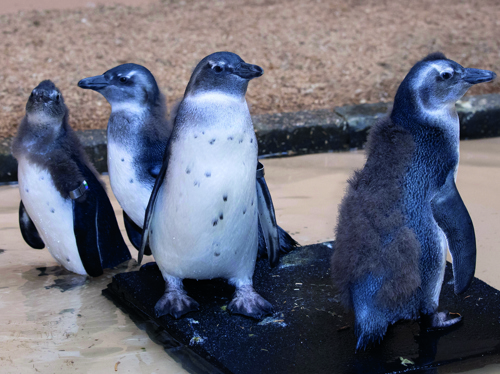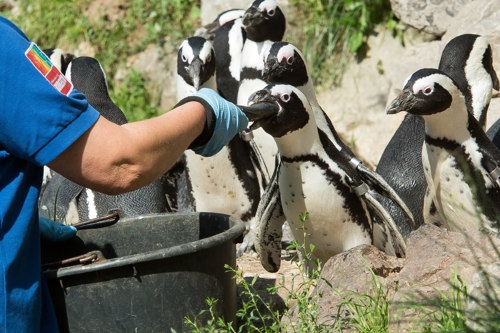
Hundreds of extraordinary animal species live at Burgers' Zoo. European population management programmes for endangered species regularly involve exchanges of animals between zoos across Europe (and sometimes beyond). There is a lot involved in planning and organising this type of transportation, including taking into account the natural behaviour and specific characteristics of an animal species, which also play a significant role in the process. In this series, we highlight several special animal transports. This time: the penguin.
Burgers' Zoo has a group of about 60 African penguins, who live in an enclosure right at the main entrance. In the wild, African penguins live on the coasts of South Africa and Namibia. They find their food in the highly nutritious sea currents around the Cape. The birds breed on land, making a hole in the rocky terrain on the beach. Most African penguins lay two eggs, which are often both fertilised.
Penguins tend to form pairs for life. Sometimes, a pair does break up, however, such as when one of the animals dies. Penguins are often transported from one zoo to another to prevent inbreeding and provide the population with fresh blood to maximise genetic diversity. When we were short of females a few years ago, we added some unrelated females from ZooParc Overloon to our colony.
We keep a very close eye on which penguins form a pair and which are their offspring. In consultation with the European population management programme coordinator, we can properly determine where to move which penguin to keep the total zoo population as genetically diverse as possible in all participating zoos.
When certain birds have raised more than enough offspring, we remove their eggs and replace them with lime eggs. The birds continue their normal brooding behaviour, but no young are born. Without lime eggs, the penguins would lay eggs again, and breeding would continue unabated. Sometimes we work the other way around and place a fertilised egg from an inexperienced pair with a successful breeding pair to optimise genetic variation. We may also move one fertilised egg from an inexperienced pair into the nest of successful breeders. They then hatch the egg and raise the chick, which is not their own.
All African penguins at Burgers' Zoo are fitted with wing tags with a unique number to identify them, as well as a chip—a legal obligation and useful when the bird loses its wing tag. The wing tags are colour-coded to make it even easier to read the numbers. Each digit has a fixed colour, e.g., 1 is white and 0 is green. A number starting with 100 will have the colour code white-green-green. If a bird is sitting on its nest and the number is difficult to read, we can still identify it without disturbing the bird by using the colour code.

African penguins usually breed twice a year. The first breeding round is just after the summer, and the first eggs are laid in September. A second breeding round often follows around November. When the chick is about seven weeks old, it is temporarily placed behind the scenes with its peers, all of whom are given a course in fish handling by the zookeeper. In the wild, chicks are kicked out of the nest by their parents not long after the first seven weeks, at which point the young birds have to fend for themselves.
At Burgers' Zoo, some chicks are quicker to catch on than others. Quick chicks pass the fish handling course in a week; slower students take a week or two. The chicks stay in the penguin crèche for about two months to gain strength and grow well. After that, the animals are placed back in the main enclosure. After a short acclimation period, they usually join the daily group feedings (twice a day: once in the morning and once in the afternoon). We always try to return young penguins to the enclosure in groups for extra support.
Penguins moult and grow new plumage in June and July. Just before the moulting season, penguins eat a lot. A penguin replaces all its feathers and looks brand new again in the space of a fortnight. During the moulting period, the birds do not or hardly swim and often eat less. Visitors often think that the "fluff balls" in the enclosure are young penguins, but appearances can be deceiving!

The African penguins at Burgers' Zoo are given preventive medicine against malaria once a week (twice a week in summer), as they are susceptible to a specific type of avian malaria. The penguins also receive special daily "fish-eater" tablets with their food, which add extra vitamins and minerals to their diet. The zookeepers insert the tablets behind the gills of the herring, which the birds swallow whole. When fish is frozen, it loses important vitamins (especially vitamin A), which the fish-eater tablets replenish.
African penguins do not require CITES documents for transport. CITES is an abbreviation for Convention on International Trade in Endangered Species. The legislation combats the illegal trade in endangered animal and plant species. The CITES status of the species determines which transport papers are required. The status of African penguins is II/B, which means we do not need to apply for CITES papers if the origin of the animal and its parents are known. When a penguin is transported, the zookeepers handle it quickly and deftly with sturdy gloves. We handle our animals as little as possible, so the penguins are not used to being handled by human hands and can peck and bite quite hard. For longer transports, each penguin gets its own transport crate.

Female manatee aged three years and nine months moved from Royal Burgers' Zoo to Faunia (Madrid) on…
7 November 2025

Burgers’ Desert to get new entrance and exit, new animal species and enclosures – the Desert Restaur…
6 November 2025

A giraffe born on Tuesday, 21 October 2025, at around 23:00, can be seen by visitors to the Arnhem z…
30 October 2025